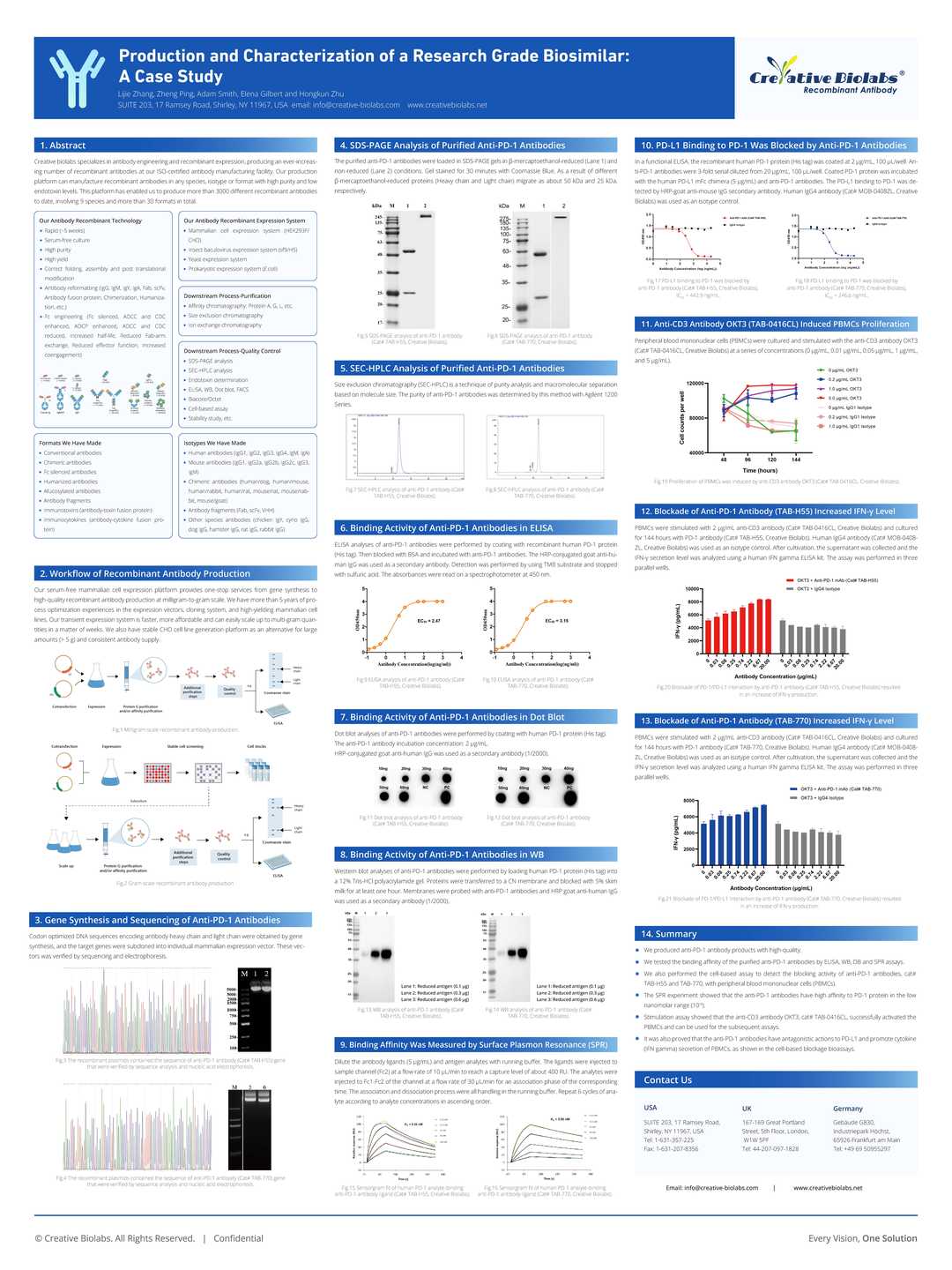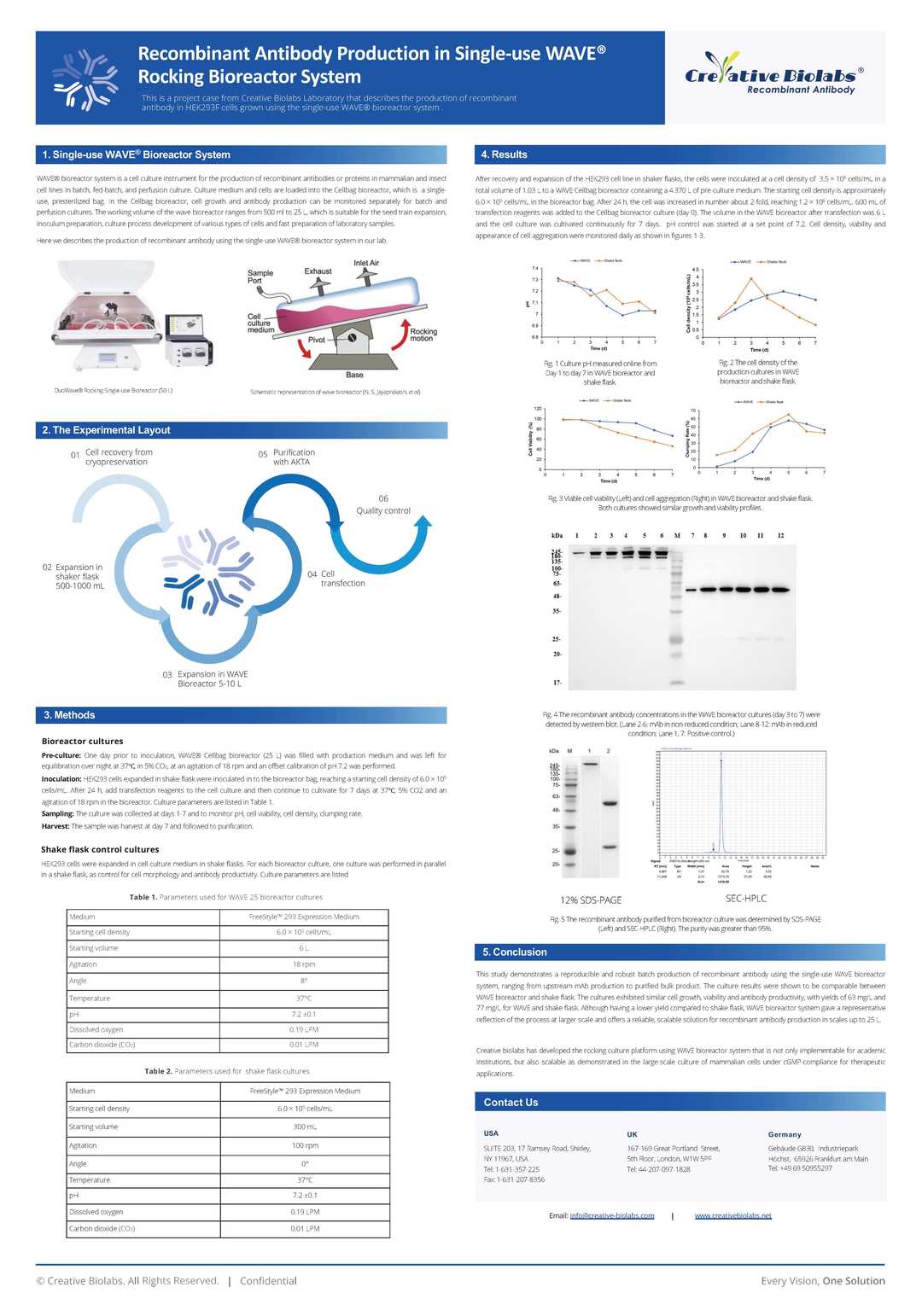Recombinant Human Anti-IAV HA Antibody (CT149)
CAT#: PABL-213
Recombinant Human Antibody (CT149) is capable of binding to IAV HA, expressed in HEK 293 cells. Expressed as the combination of a heavy chain (HC) containing VH from anti-IAV HA mAb and CH1-3 region of human IgG1 and a light chain (LC) encoding VL from anti-IAV HA mAb and CL of human kappa light chain. Exists as a disulfide linked dimer of the HC and LC hetero-dimer under non-reducing condition. This antibody is found to neutralize all tested group 2 and some group 1 influenza A viruses by inhibiting low pH-induced, HA-mediated membrane fusion.









Specifications
- Immunogen
- Influenza a virus Hemagglutinin
- Host Species
- Human
- Derivation
- Human
- Type
- IgG
- Specificity
- Tested positive against native IAV HA
- Species Reactivity
- IAV
- Clone
- CT149
- Applications
- Can be useful in applications such as: Western blot; Neutralization; Functional Study
Product Property
- Purity
- >95% by SDS-PAGE and HPLC analysis
- Storage
- Store the antibody (in aliquots) at -20°C. Avoid repeated freezing and thawing of samples.
Target
- Alternative Names
- HA; hemagglutinin; haemagglutinin
Customer Review
There are currently no Customer reviews or questions for PABL-213. Click the button above to contact us or submit your feedback about this product.
 Jessica Hill
Jessica Hill David Adams
David Adams Megan Martinez
Megan MartinezQ&As
-
Is the anti-IAV HA antibody suitable for use in Western blotting?
A: Yes, the anti-IAV HA antibody (PABL-213) is suitable for use in Western blotting. It provides specific binding to the HA protein, allowing for reliable detection in Western blot assays.
-
What are the storage recommendations for the anti-IAV HA antibody?
A: The recommended storage condition for the anti-IAV HA antibody (PABL-213) is at -20°C or lower. For short-term storage, it can be kept at 2-8°C. To ensure stability, avoid repeated freeze-thaw cycles.
-
Can the anti-IAV HA antibody be used in immunoprecipitation assays?
A: Yes, the anti-IAV HA antibody (PABL-213) can be used in immunoprecipitation assays. It provides specific binding to the HA protein, enabling the successful precipitation of the target protein from complex mixtures.
-
Is the anti-IAV HA antibody effective in ELISA applications?
A: Yes, the anti-IAV HA antibody (PABL-213) is effective in ELISA applications. It has been validated for use in such assays and provides reliable detection of the HA protein.
-
What is the optimal dilution for using the anti-IAV HA antibody in immunofluorescence?
A: The optimal dilution for using the anti-IAV HA antibody (PABL-213) in immunofluorescence is typically 1:100 to 1:500. It is advisable to perform a dilution series to determine the best working concentration for your specific experimental conditions.
View the frequently asked questions answered by Creative Biolabs Support.
Citations
-
Park, Jae-Keun, et al. "Pre-existing immunity to influenza virus hemagglutinin stalk might drive selection for antibody-escape mutant viruses in a human challenge model." Nature medicine 26.8 (2020): 1240-1246. https://doi.org/10.1038/s41591-020-0937-xThis study investigates the selection of an HA stalk antibody-escape mutant virus in human influenza challenge participants. The researchers focused on a well-characterized influenza A virus stock containing a mixed population of wild-type and mutant viruses with a nonsynonymous single-nucleotide polymorphism (SNP) in the HA stalk (A388V). They analyzed pre-existing anti-HA stalk antibody levels and post-challenge viral shedding in participants, revealing that higher pre-challenge anti-HA stalk antibody titers were associated with the selection of the mutant virus. The study found that the A388V mutation conferred resistance to some broadly neutralizing monoclonal antibodies (bNAbs) and was rapidly selected under immune pressure, highlighting a potential challenge for HA-stalk-targeting universal influenza vaccines.
Creative Biolabs provided several key reagents for this research, including the broadly neutralizing monoclonal antibodies CR9114 (Cat#: PABX-119), FI6V3 (Cat#: PABL-214), and CT149 (Cat#: PABL-213). These antibodies were essential for evaluating the binding and neutralization characteristics of the mutant and wild-type viruses. The specific contributions of these antibodies were crucial for understanding the structural changes and resistance mechanisms conferred by the A388V mutation, thereby aiding in the comprehensive analysis of HA stalk antibody escape and its implications for vaccine development.
Cite This Product
To accurately reference this product in your publication, please use the following citation information:
(Creative Biolabs Cat# PABL-213, RRID: AB_3111638)
Submit Your Publication
Published with our product? Submit your paper and receive a 10% discount on your next order! Share your research to earn exclusive rewards.
Downloadable Resources
Download resources about recombinant antibody development and antibody engineering to boost your research.
Product Notes
This is a product of Creative Biolabs' Hi-Affi™ recombinant antibody portfolio, which has several benefits including:
• Increased sensitivity
• Confirmed specificity
• High repeatability
• Excellent batch-to-batch consistency
• Sustainable supply
• Animal-free production
See more details about Hi-Affi™ recombinant antibody benefits.
Datasheet
MSDS
COA
Certificate of Analysis LookupTo download a Certificate of Analysis, please enter a lot number in the search box below. Note: Certificate of Analysis not available for kit components.
See other products for "Clone CT149"
- CAT
- Product Name
See other products for "HA"
Select a product category from the dropdown menu below to view related products.
| CAT | Product Name | Application | Type |
|---|---|---|---|
| PFBL-203 | Recombinant Human Anti-IAV HA Antibody Fab Fragment (3.1) | WB, ELISA, FuncS | Fab |
| PFBL-204 | Recombinant Human Anti-IAV HA Antibody Fab Fragment (39.29) | Neut, FuncS | Fab |
| PFBL-205 | Recombinant Human Anti-IAV HA Antibody Fab Fragment (1957) | WB, Neut, FuncS | Fab |
| PFBL-206 | Recombinant Human Anti-IAV HA Antibody Fab Fragment (1F1) | WB, ELISA, FuncS | Fab |
| PFBL-207 | Recombinant Human Anti-IAV HA Antibody Fab Fragment (5J8) | WB, ELISA, FuncS | Fab |
| CAT | Product Name | Application | Type |
|---|---|---|---|
| PABL-482 | Recombinant Human Anti-H1N1 HA Antibody (PABL-482) | FuncS, Neut, WB | IgG |
| PABL-483 | Recombinant Human Anti-H1N1 HA Antibody (CH67) | IF, FC | IgG |
| PABL-484 | Recombinant Human Anti-H1N1 HA Antibody (I2) | Neut | IgG |
| PABL-485 | Recombinant Mouse Anti-H1N1 HA Antibody | WB, ELISA, FuncS | IgG |
| PABL-487 | Recombinant Human Anti-H2N2 HA Antibody (2G1 ) | FuncS | IgG |
| CAT | Product Name | Application | Type |
|---|---|---|---|
| PFBC-233 | Recombinant Human Anti-H3N2 HA Antibody Fab Fragment (F045-092) | Neut | Fab |
| FAMAB-0149-YC-S(P) | Recombinant Human Anti-HA Antibody scFv Fragment (FAMAB-0149-YC-S(P)) | ELISA, FC, Neut | Human scFv |
| FAMAB-0150-YC-S(P) | Recombinant Human Anti-HA Antibody scFv Fragment (FAMAB-0150-YC-S(P)) | FC, Neut | Human scFv |
| FAMAB-0151-YC-S(P) | Recombinant Human Anti-HA Antibody scFv Fragment (FAMAB-0151-YC-S(P)) | FC, Neut | Human scFv |
| FAMAB-0277-YC-S(P) | Recombinant Mouse Anti-HA Antibody scFv Fragment (T1-107) | ELISA | Mouse scFv |
| CAT | Product Name | Application | Type |
|---|---|---|---|
| MRO-241CT | Anti-IAV HA Recombinant Antibody (D1-1) | WB, FC, IP, Inhib | Human antibody |
| MRO-242CT | Anti-IAV HA Recombinant Antibody (D1-2) | WB, FC, IP, Inhib | Human antibody |
| MRO-243CT | Anti-IAV HA Recombinant Antibody (D1-3) | WB, FC, IP, Inhib | Human antibody |
| MRO-244CT | Anti-IAV HA Recombinant Antibody (D1-4) | WB, FC, IP, Inhib | Human antibody |
| MRO-245CT | Anti-IAV HA Recombinant Antibody (D1-5) | WB, FC, IP, Inhib | Human antibody |
| CAT | Product Name | Application | Type |
|---|---|---|---|
| MRO-301CT | Anti-IAV HA Recombinant Antibody (3741 ) | WB, ELISA |
| CAT | Product Name | Application | Type |
|---|---|---|---|
| MRO-302CT | Anti-IAV HA Recombinant Antibody (Al7) | WB, ELISA, S-ELISA, IHC | |
| MRO-303CT | Anti-IAV HA Recombinant Antibody (2242) | WB, ELISA | |
| MRO-304CT | Anti-IAV HA Recombinant Antibody (10916) | WB, ELISA | |
| MRO-305CT | Anti-IAV HA Recombinant Antibody (M321) | WB, ELISA | |
| MRO-306CT | Anti-IAV HA Recombinant Antibody (T124) | WB, ELISA |
| CAT | Product Name | Application | Type |
|---|---|---|---|
| PABX-070-S (P) | Recombinant Mouse Anti-HA1 Antibody scFv Fragment (Fab17/9) | WB, ELISA, Neut, FuncS | scFv |
| CAT | Product Name | Application | Type |
|---|---|---|---|
| MOR-4209 | Hi-Affi™ Recombinant Rabbit Anti-HA Monoclonal Antibody (SI287DS) | ELISA, ICC, IF, IF, FC | IgG |
| MOR-4210 | Hi-Affi™ Recombinant Rabbit Anti-HA Monoclonal Antibody (SI288DS) | ELISA, ICC, IF, IF, FC | IgG |
| CAT | Product Name | Application | Type |
|---|---|---|---|
| MHC-CN0765 | PE-DRB1*04:01/Influenza HA (PKYVKQNTLKLAT) MHC Tetramer | FCM, IHC | |
| MHC-CN0766 | APC-DRB1*04:01/Influenza HA (PKYVKQNTLKLAT) MHC Tetramer | FCM, IHC | |
| MHC-CN0767 | FITC-DRB1*04:01/Influenza HA (PKYVKQNTLKLAT) MHC Tetramer | FCM, IHC | |
| MHC-CN0768 | DRB1*04:01/Influenza HA (PKYVKQNTLKLAT) MHC Tetramer | FCM, IHC | |
| MHC-YF1194 | PE-DRB1*04:02/Human HA (PKYVKQNTLKLAT) MHC Tetramer | FCM |
| CAT | Product Name | Application | Type |
|---|---|---|---|
| HPAB-1169-FY | Llama Anti-HA Recombinant Single Domain Antibody (HPAB-1169-FY) | Neut | Llama VHH |
| HPAB-1170-FY | Llama Anti-HA Recombinant Single Domain Antibody (HPAB-1170-FY) | Neut | Llama VHH |
| HPAB-1171-FY | Llama Anti-HA Recombinant Single Domain Antibody (HPAB-1171-FY) | Neut | Llama VHH |
| HPAB-1172-FY | Llama Anti-HA Recombinant Single Domain Antibody (HPAB-1172-FY) | Neut | Llama VHH |
| HPAB-1173-FY | Llama Anti-HA Recombinant Single Domain Antibody (HPAB-1173-FY) | Neut | Llama VHH |
Popular Products

Application: Neut, ELISA, IF, IP, FuncS, FC, IHC

Application: FC, IHC, FuncS, Inhib, Cyt

Application: WB, ELISA, FC, IHC, IP

Application: Neut, FC, IHC-Fr, IP, BA

Application: FC, IHC, Cyt, FuncS

Application: ELISA, IHC, IF, IP
For research use only. Not intended for any clinical use. No products from Creative Biolabs may be resold, modified for resale or used to manufacture commercial products without prior written approval from Creative Biolabs.
This site is protected by reCAPTCHA and the Google Privacy Policy and Terms of Service apply.















-2.png)














